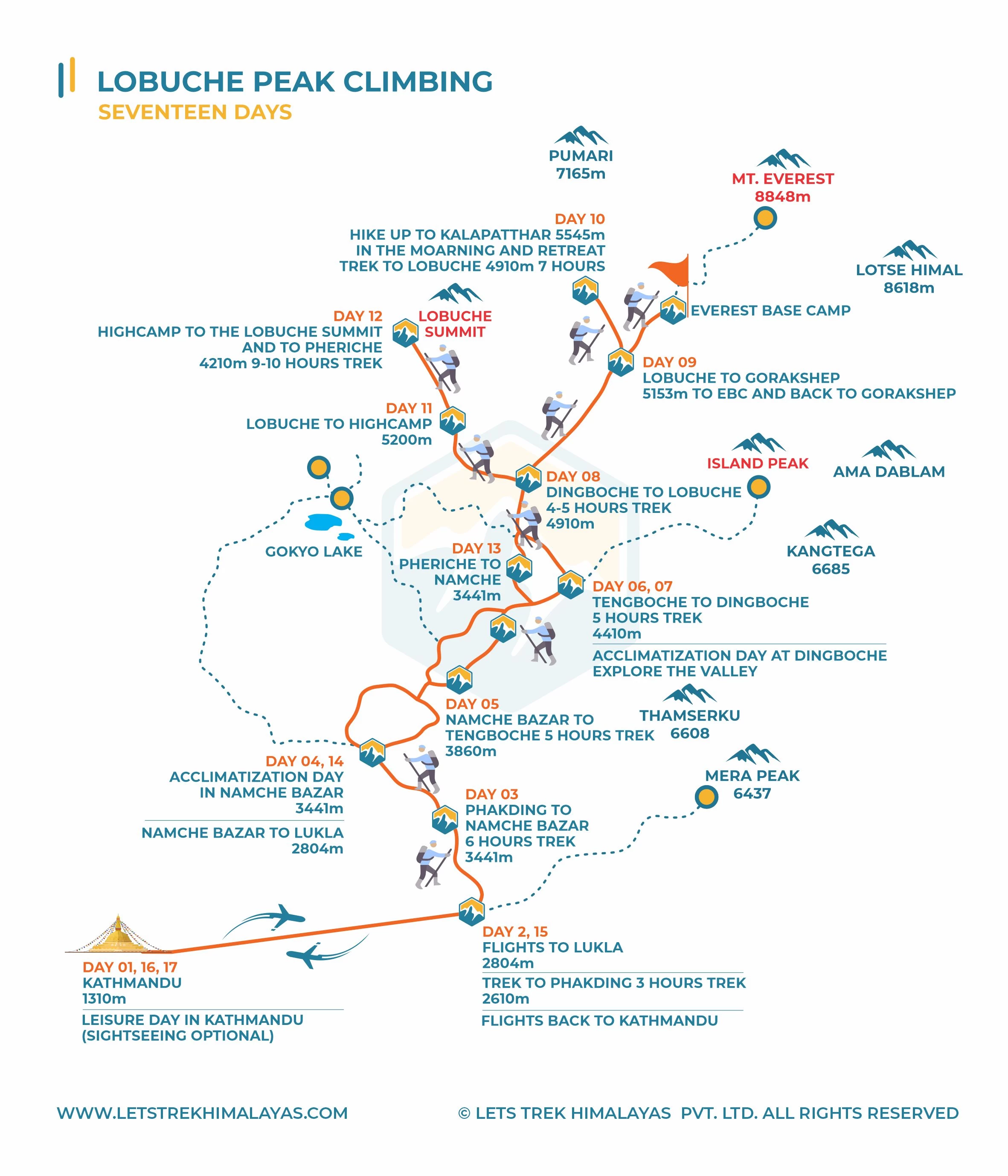The magnificent Lobuche Peak is located at a height of 6,119 meters (20,075 ft) above sea level. We will follow the classic Everest Trail as we make our way through the stunning Khumbu Valley on the way to climbing Lobuche Peak. In Namche Bazar, the Sherpa heartland of the region, where we will spend three nights acclimatization along the trail. As we pass various peaks at 7,500 and 8,500 meters on the trek, we will also see stunning monasteries and breathtaking scenery.
Your journey to Namche Bazaar and Tengboche Monastery. These places are renowned for their intriguing histories, picturesque settings, and, in the case of the Tengboche Monasteries, breathtaking views. We continue on the Everest Base Camp Trek till we reach Kalapatthar at 5,550 m, where there are stunning views of Mount Everest and the surrounding high peaks. You tour Everest Base Camp while spending the night at Gorakshep (5,180 meters).
The standard trekking route deviates from our trail to Lobuche Peak. High Camp is located at 5,400 meters above sea level, whereas Lobuche Base Camp is located in the Lobuche Village itself.
Our climbing Sherpa crew will instruct/refresh climbers on the fundamental use of the climbing equipment once they arrive at Lobuche Base Camp. To avoid the strong winds later in the day, we start the summit ascent around 2:00 AM.
What to Expect at Lobuche Peak Climbing
Lobuche Peak A technical mountaineering adventure Compared to other Nepalese hiking peaks, it is difficult. The view is the most captivating feature of climbing Lobuche. Incredibly beautiful in every direction, the sight to witness. Climbers will experience a sense of mountain surround. The view of the Khumbu region from the top is unparalleled, aside from the mountain vistas.
Do not be misled by Lobuche's apparent height—it is 6119 meters high. One of the hardest trekking summits is this one. However, climbers must be aware of the climate and the people of the Himalayas. To climb the mountains of Nepal, especially Lobuche, a climber has to have a few specific qualities, including physical fitness, knowledge of high altitudes, and fortitude.
It is yet another enhancement to Khumbu's magnificence, which passionate mountaineers scale. It is breathtaking, with its neighboring snow-capped peaks like Ama Dablam and Pokalde, dazzling glaciers, and varied landscapes.
Lobuche East Peak is a natural wonder that is situated close to Khumbu Glacier in the northeast of Nepal. With magnificent valleys, enchanting villages, and epic scenery, it is as wonderful as it gets.
While the settlement is located at an elevation of 4,930 meters, the peak rises to a height of 6119 meters. To reach the peak, it must cross the ice terrain, through a deep cleft ridge, and climb steep glaciers.
Following Lobuche Peak are some fairly impressive pastoral pathways. Trekkers can find lovely villages, mountain ridges, and glaciers thanks to it. Visitors can catch a glimpse of the glistening snow-capped peaks of Thamserku, Cholatse, and Kantega from the summit of the acme.
Preparation for Lobuche Peak Climbing
We are serious about climbing Lobuche Peak, and you should be too. Your level of success will depend on a variety of elements. First of all, you need a schedule that allows you enough acclimatization. Both Lobuche Peak High Camps are used for your success and satisfaction. The second step is to create a training schedule that is appropriate for the unique aspects of the trip. Last but not least, be sure you are familiar with the special fixed-line climbing techniques used in the Himalayas for high-altitude glacier safety.
By gradually extending the duration of your cardiovascular exercise sessions, you can increase your endurance training. For instance, you should train for an hour and a half a day, four to five days a week, before you travel. Try to maintain a steady heart rate within your endurance limit as you do this. Weight should be used when doing this.
To further develop your strength and endurance, you should add a longer workout or hike once a week. This hike could last up to 6 hours and involve climbing and descending hills. It is not a sort of training that is universally applicable, and each person may require a different approach. Take a fitness assessment to help you maximize your training effectiveness.

